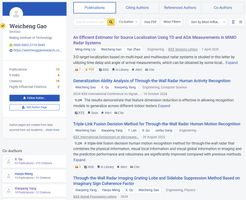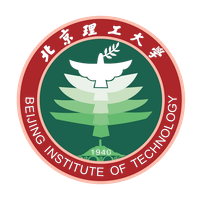
Education (教育经历)
2018.09~2022.06, Beijing Institute of Technology, Xu Teli Class of Excellence, Bachelor;
2018.09~2022.06,北京理工大学,徐特立英才班,学士;
2022.09~Now, Beijing Institute of Technology, School of Information and Electronics, Doctor (Hump Pilot Program Rewarded), guided by Prof. Xiaopeng Yang.
2022.09~至今,北京理工大学,信息与电子学院,博士(驼峰领航计划),师从杨小鹏教授。
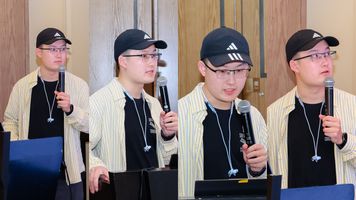
Science Activities (科技活动)
Participation at domestic and international conferences, forums, and research platforms
2024, Zhidx Autonomous Driving New Youth Lecture Radar Perception Forum, delivered an invited report;
2024年智东西自动驾驶新青年讲座雷达感知论坛,作【特邀报告】;
2024, Multi-source Information Perception Doctoral Forum, delivered a session report, won the Best Report Award;
2024年多源信息感知博士生论坛,作论坛报告,获【最佳报告】奖;
2024, IEEE ICSIDP International Conference, delivered a session report, won the Best Paper Award;
2024年IEEE ICSIDP国际会议,作分会场报告,获【最佳论文】奖;
2023, Beijing Institute of Technology Xu Teli Academic Forum, delivered a session report, won the Best Paper Award;
2023年北理工徐特立学术论坛,作分会场报告,获【最佳论文】奖;
2024, Journal of Radars Fourth Doctoral Forum, delivered a session report, won the Excellent Report Award;
2024年雷达学报第四届博士论坛,作论坛报告,获【优秀报告】奖;
Founder of the "Signals, Machine Learning and Radar" series column in the Zhihu technology field, awarded the title of "Sea Salt Plan" high-quality creator;
知乎科技领域《信号,机器学习与雷达》系列专栏创始人,获【“海盐计划”优质创作者】称号;
2022, APSIPA International Conference, delivered a session report;
2022年APSIPA国际会议,作分会场报告;
2022, IEEE MAPE International Conference, delivered a session report;
2022年IEEE MAPE国际会议,作分会场报告;
2022, Beijing Institute of Technology Xu Teli Academic Forum, delivered a session report;
2022年北理工徐特立学术论坛,作分会场报告;
2023, IET International Radar Conference, assisted supervisor in delivering a conference report;
2023年IET国际雷达会议,协助导师作大会报告;
2023, IEEE ICICSP International Conference, assisted supervisor in delivering an invited report;
2023年IEEE ICICSP国际会议,协助导师作特邀报告;
2024, Radar Future Conference, assisted supervisor in delivering an invited report;
2024 年雷达未来大会,协助导师作特邀报告;
2024, Electromagnetic Spectrum Conference, assisted supervisor in delivering an invited report;
2024年电磁频谱大会,协助导师作特邀报告;
2025, Electronic Information Annual Conference, assisted supervisor in delivering an invited report.
2025年电子信息年会,协助导师作特邀报告。
My Publications (发表成果)
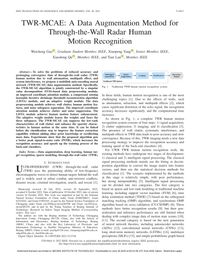
W. Gao, X. Yang, X. Qu and T. Lan, “TWR-MCAE: A Data Augmentation Method for Through-the-Wall Radar Human Motion Recognition,” in IEEE Transactions on Geoscience and Remote Sensing, vol. 60, pp. 1-17, 2022.
(SCI, JCR Q1)

X. Qu, W. Gao, H. Meng, Y. Zhao and X. Yang, “Indoor Human Behavior Recognition Method Based on Wavelet Scattering Network and Conditional Random Field Model,” in IEEE Transactions on Geoscience and Remote Sensing, vol. 61, pp. 1-15, 2023.
(SCI, JCR Q1)
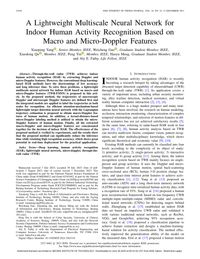
X. Yang, W. Gao, X. Qu, P. Yin, H. Meng and A. E. Fathy, “A Lightweight Multiscale Neural Network for Indoor Human Activity Recognition Based on Macro and Micro-Doppler Features,” in IEEE Internet of Things Journal, vol. 10, no. 24, pp. 21836-21854, 2023.
(SCI, JCR Q1)
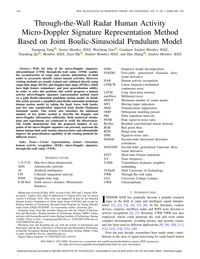
X. Yang, W. Gao, X. Qu, Z. Ma and H. Zhang, “Through-the-Wall Radar Human Activity Micro-Doppler Signature Representation Method Based on Joint Boulic-Sinusoidal Pendulum Model,” in IEEE Transactions on Microwave Theory and Techniques, vol. 73, no. 2, pp. 1248-1263, 2025.
(SCI, JCR Q1)

X. Yang, W. Gao, X. Qu and H. Meng, “Generalizable Indoor Human Activity Recognition Method Based on Micro-Doppler Corner Point Cloud and Dynamic Graph Learning,” in IEEE Transactions on Aerospace and Electronics Systems, vol. 61, no. 2, pp. 5195-5209, 2024.
(SCI, JCR Q1)

W. Gao, X. Qu, H. Meng, X. Sun and X. Yang, “Adaptive Micro-Doppler Corner Feature Extraction Method Based on Difference of Gaussian Filter and Deformable Convolution,” in IEEE Signal Processing Letters, vol. 31, pp. 860-864, 2024.
(SCI, JCR Q2)
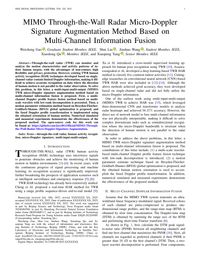
W. Gao, S. Liu, J. Wang, X. Qu and X. Yang, “MIMO Through-the-Wall Radar Micro-Doppler Signature Augmentation Method Based on Multi-Channel Information Fusion,” in IEEE Signal Processing Letters, 2025.
(SCI, JCR Q2)
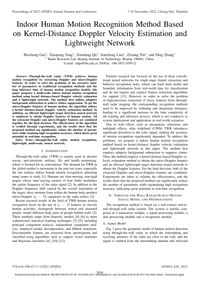
W. Gao, X. Yang, X. Qu, J. Liao, Z. Yin and D. Zhang, “Indoor Human Motion Recognition Method Based on Kernel-Distance Doppler Velocity Estimation and Lightweight Network,” in Asia-Pacific Signal and Information Processing Association Annual Summit and Conference (APSIPA ASC), Chiang Mai, Thailand, 2022.
(EI)
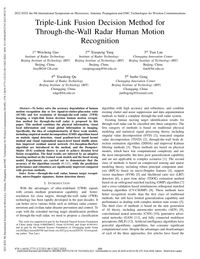
W. Gao, X. Yang, T. Lan, X. Qu and J. Gong, “Triple-Link Fusion Decision Method for Through-the-Wall Radar Human Motion Recognition,” in IEEE International Symposium on Microwave, Antenna, Propagation and EMC Technologies for Wireless Communications (MAPE), Chengdu, China, 2022.
(EI)
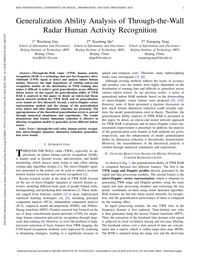
W. Gao, X. Qu and X. Yang, “Generalization Ability Analysis of Through-the-Wall Radar Human Activity Recognition,” in IEEE International Conference on Signal, Information and Data Processing (ICSIDP), Zhuhai, China, 2024.
(EI)
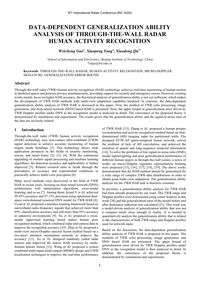
W. Gao, X. Yang and X. Qu, “Data-Dependent Generalization Ability Analysis Of Through-the-Wall Radar Human Activity Recognition,” in IET International Radar Conference (IRC), Jiaxing, China, 2025.
(EI)
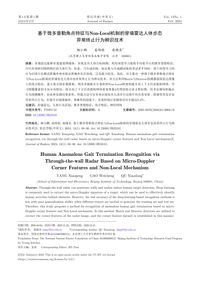
杨小鹏, 高炜程, 渠晓东. 基于微多普勒角点特征与Non-Local机制的穿墙雷达人体步态异常终止行为辨识技术[J]. 雷达学报, 2024, 13(1).
(EI)
GiHub Link: https://github.com/JoeyBGOfficial/Through-the-Wall-Radar-Human-Activity-Recognition-Based-on-M-D-Corner-Feature-and-Non-Local-Net
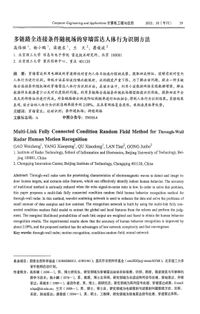
杨小鹏, 高炜程, 渠晓东, 兰天, 龚俊波. 多链路全连接条件随机场的穿墙雷达人体行为识别方法[J]. 计算机工程与应用, 2022, 58.
(EI)

X. Yang, H. Meng, Z. Ma, X. Qu, W. Gao and Y. Zhao, “Azimuth Sidelobe Suppression Method for Through-the-Wall Radar Based on Phase Nonuniform Quantized Coherence Factor,” in IEEE Transactions on Aerospace and Electronic Systems, vol. 61, no. 3, pp. 7140-7152, 2025.
(SCI, JCR Q1)
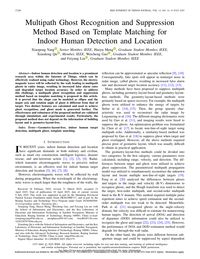
X. Yang, H. Meng, X. Qu, W. Gao and F. Liu, “Multipath Ghost Recognition and Suppression Method Based on Template Matching for Indoor Human Detection and Location,” in IEEE Internet of Things Journal, vol. 12, no. 14, pp. 27280-27290, 2025.
(SCI, JCR Q1)
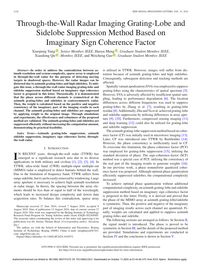
X. Yang, H. Meng, X. Qu, W. Gao, "Through-the-Wall Radar Imaging Grating-lobe and Sidelobe Suppression Method Based on Imaginary Sign Coherence Factor," in IEEE Signal Processing Letters, vol. 31, pp. 2120-2124, 2024.
(SCI, JCR Q2)
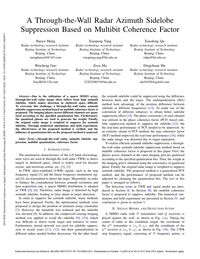
H. Meng, X. Yang, X. Qu, W. Gao, Z. Ma and D. Shi, “A Through-the-Wall Radar Azimuth Sidelobe Suppression Based on Multibit Coherence Factor,” in IEEE International Conference on Signal, Information and Data Processing (ICSIDP), Zhuhai, China, 2024.
(EI)
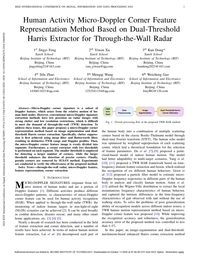
J. Feng, Y. Xu, K. Dong, S. Zhao, M. Wang and W. Gao, “Human Activity Micro-Doppler Corner Feature Representation Method Based on Dual-Threshold Harris Extractor for Through-the-Wall Radar,” in IEEE International Conference on Signal, Information and Data Processing (ICSIDP), Zhuhai, China, 2024.
(EI)
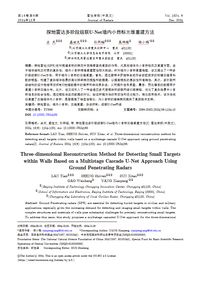
兰天, 盛世文, 孙熙韬, 高炜程, 杨小鹏. 探地雷达多阶段级联U-Net墙内小目标三维重建方法[J]. 雷达学报, 2024, 13(6).
(EI)
Research in Interest (兴趣研究)
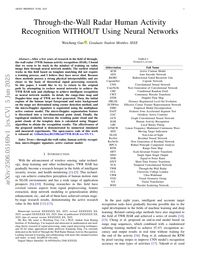
W. Gao, “Through-the-Wall Radar Human Activity Recognition WITHOUT Using Neural Networks,” arXiv (Cornell University), June. 2025.
GitHub Link: https://github.com/JoeyBGOfficial/Through-the-Wall-Radar-Human-Activity-Recognition-Without-Using-Neural-Networks
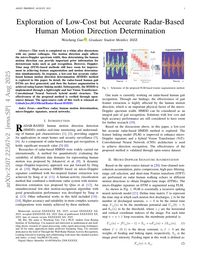
W. Gao, “Exploration of Low-Cost but Accurate Radar-Based Human Motion Direction Determination,” arXiv (Cornell University), Aug. 2025.
GitHub Link: https://github.com/JoeyBGOfficial/Low-Cost-Accurate-Radar-Based-Human-Motion-Direction-Determination
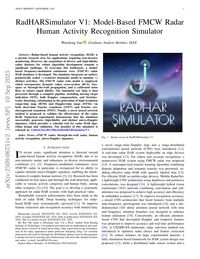
W. Gao, “RadHARSimulator V1: Model-Based FMCW Radar Human Activity Recognition Simulator,” arXiv (Cornell University), Sep. 2025.
GitHub Link: https://github.com/JoeyBGOfficial/RadHARSimulatorV1-Model-Based-FMCW-Radar-Human-Activity-Recognition-Simulator
Awards & Titles (奖励及荣誉称号)
Awarded the First Prize for Technology Invention Award from the China Radar Industry Association in 2023 (Ranked 6th);
获2023年度中国雷达行业协会技术发明一等奖(序6);
Selected as a member of the Young Professionals in the IEEE GRSS community;
入选IEEE GRSS社区Young Professionals成员;
Selected for the Reserve Talent Training Program for Scientific and Technological Innovation by the China Association for Science and Technology;
入选中国科协科技创新后备人才培养计划;
Won the Second Prize in the 9th "Share Cup" Science and Technology Innovation Competition in 2022 (Ranked 1st);
获2022年第九届共享杯科创竞赛全国二等奖(序1);
Awarded the Outstanding Undergraduate Thesis of Beijing in 2022;
获2022年北京市优秀本科毕业设计;
Awarded the F5000 Award for the Top Papers in China's High-Quality Scientific and Technological Journals in 2025 (student, Ranked 1st);
获2025中国精品科技期刊顶尖论文F5000奖(学生序1);
Awarded the Excellent Paper of the Year Award from the Journal of Radars in 2024 (student, Ranked 1st);
获2024年雷达学报年度优秀论文奖(学生序1);
Served as a reviewer for top SCI journals such as IEEE IoT, TGRS, TIM, and TMTT; recognized as an outstanding reviewer for the high-level SCI journal "Journal of Supercomputing" in the field of computational theory, with a cumulative total of over 40 completed reviews;
任IEEE IoT、TGRS、TIM、TMTT等SCI顶级期刊审稿人,获计算理论领域SCI高水平期刊Journal of Supercomputing优秀审稿人,累计已完成审稿工作40余篇;
Won the Best Presentation Award at the Doctoral Forum on Multi-source Information Sensing in 2024;
获2024年多源信息感知博士生论坛最佳报告奖;
Won the Excellent Presentation Award at the Doctoral Forum of the Journal of Radars in 2024;
获2024年雷达学报博士论坛优秀报告奖;
Selected for the "Hump Navigation" Top-notch Innovative Talent Training Program at Beijing Institute of Technology in 2022;
入选2022年北京理工大学“驼峰领航”拔尖创新人才培育计划;
Won the Best Paper Award at the Xu Teli Academic Forum of Beijing Institute of Technology in 2023 (Ranked 1st);
获2023年北京理工大学徐特立学术论坛最佳论文奖(序1);
Awarded National Scholarship for Doctoral Students in 2025;
获2025年博士研究生国家奖学金;
Awarded the title of "Outstanding Student" at Beijing Institute of Technology in 2023;
获2023年北京理工大学优秀学生;
Awarded the Special Scholarship for Doctoral Students at Beijing Institute of Technology in 2023;
获2023年北京理工大学博士生特等奖学金;
Awarded the Special Scholarship for Doctoral Students at Beijing Institute of Technology in 2022;
获2022年北京理工大学博士生特等奖学金;
Awarded the title of "Outstanding Graduate" at Beijing Institute of Technology in 2022;
获2022年北京理工大学优秀毕业生;
Awarded the award for Outstanding Undergraduate Thesis at Beijing Institute of Technology in 2022;
获2022年北京理工大学优秀本科毕业设计;
Won the award for Excellent Moral Education Defense at Beijing Institute of Technology in 2022;
获2022年北京理工大学优秀德育答辩奖;
Awarded the title of "Excellent League Member" at Beijing Institute of Technology in 2022;
获2022年北京理工大学优秀团员;
Won the First Prize in the "Century Cup" Science and Technology Innovation Competition at Beijing Institute of Technology in 2021 (Ranked 1st);
获2021年北京理工大学“世纪杯”科创竞赛一等奖(序1);
Recognized as a "Role Model of the Times and Youth" by Xu Teli College, Beijing Institute of Technology in 2020;
获2020年北京理工大学徐特立学院时代青春榜样;
Established and Served as the Vice Minister and Student Advisor of the Radar Club at Beijing Institute of Technology;
建立并北京理工大学雷达俱乐部、任副部长、学生顾问;
Served as a peer mentor for the 2020 Physics Strengthen Foundation Class at Beijing Institute of Technology and was awarded the title of "Excellent Peer Mentor";
任北京理工大学2020级物理强基班朋辈导师,获优秀朋辈导师称号;
Served as a graduate mentor for the "University Students' Innovation and Entrepreneurship Training Program", winning the Best Paper Award at the 2024 IEEE ICSIDP International Conference, and receiving honorary titles such as the "Beijing Natural Science Foundation Undergraduate 'Qiyan' Program", the "Beijing Institute of Technology Teli Student Science and Technology Innovation Team", and the "Beijing Institute of Technology Excellent University Students' Innovation and Entrepreneurship Training Program Project".
任大创指导研究生,获2024年IEEE ICSIDP国际会议最佳论文奖、获批“北京市自然科学基金本科生‘启研’计划”、“北京理工大学特立学生科技创新团队”、“北京理工大学优秀大创项目”等荣誉称号。


Let's Keep in Touch (我的联系方式)
I've chosen these businesses out of pure love, so I'm looking forward to making more like-minded friends




